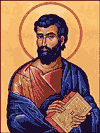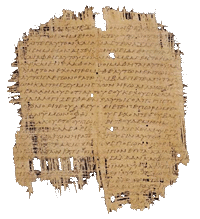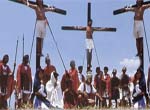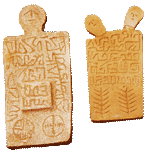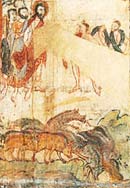The world went on, despite the fall of the Temple, so Mark has Jesus say ‘the end shall not be yet.’ (13.7). Mark is discounting any idea that the destruction of the first Jewish war would have signalled the ‘end time’ – indicative that he was writing long after conflict of 66-70 AD. Famously, the godman says ‘you shall hear of wars and rumours of wars’, which nicely covers all the subsequent rebellions of the early decades of the second century.
All this ‘prophecy’ of the so-called ‘little Apocalypse’ of Mark 13 actually fits much better a later date.
The clues are there: 1. ‘false’ Christs:
‘false Christs and false prophets shall rise, and shall shew signs and wonders, to seduce, if it were possible, even the elect.’(13,22)
This reference fits Simon ben Kosiba (punned into a portentous ‘Bar Kochba’ or ‘son of the star’ by his followers) better than any other ‘false prophet’. Many beside himself considered him the Messiah and, with the blessing of the High Priest, Bar Kochba led the war against Rome from 132-136. He was said to have spewed fire from his mouth – not a particularly difficult ‘wonder’ to have mastered, as Jerome later reported:
‘That famed Barchochebas, the instigator of the Jewish uprising, kept fanning a lighted blade of straw in his mouth with puffs of breath so as to give the impression that he was spewing out flames.’
– Jerome (Against Rufinus, 3.31)
The remainder of Mark is taken up with ‘the Passion’ and oddly, the original Mark ends abruptly – and without sight of any resurrected Christ! Frightened women flee an empty tomb and ‘tell no-one’ (16.8). Unabashed later Christian writers will add an improved, more satisfying ending.
The internal dating evidence for Mark comes from the fact that Mark has his Jesus ‘prophesy’ the destruction of the Temple in 70 AD. Mark makes it the last public discourse of Jesus before his arrest:
‘And Jesus answered and said to him, “Do you see these great buildings? Not one stone shall be left upon another, that shall not be thrown down.” ’
– Mark 13.2
Christian writers (as early as Irenaeus) have used this earliest possible date for Mark as definitive – making the jump that as there are no obvious references to events later than 70 AD, we have Mark’s date of origin. However, a well-known event like the fall of the Temple could have been placed in the story anytime after it had occurred, as early as 70 AD – or as late as 170 AD !
The real clues are more cryptic.
2: Persecution, especially persecution from Jews:
‘for they shall deliver you up to councils; and in the synagogues you shall be beaten…’(13.9)
In the 90s the Jews first introduced a curse upon ‘apostates’ and Jewish hostility to the Jewish/Christian heretics was greatest between 100 – 120 AD. The second Jewish war, unfortunately, did not have its Josephus to record the events but it was, in fact, a larger conflict. It had the more profound consequence of wiping Judaea off the map.
3. A final clue is a cryptic reference from Daniel 9.27 which in the original referred to Antiochus profaning the Temple of Jerusalem c.165 BC, with an image of Zeus.
‘The abomination of desolation, spoken of by Daniel the prophet, standing where it ought not, (let the reader understand,) then let them that be in Judaea flee to the mountains: … And pray that your flight be not in the winter.’(13.14,18)
Some have speculated that this refers to Caligula’s intention of placing a statue of himself in the Temple, announced in 40 AD. But the statue was never erected; Caligula was assassinated in 41 AD. Now in fact Hadrian purposefully modelled himself on Antiochus Epiphanes and the catalyst for the second Jewish revolt was his erection of not merely a statue of Zeus/Jupiter, along with his own image, but an entire temple to the god. The most terrible war followed.
The little aside that Mark adds ‘Let the reader understand’ seems to indicate that he knows calling the temple of Jupiter ‘an abomination’ could be regarded as seditious, and Hadrian came down hard on the Jews after the war of 135 AD. If Mark were just referring to the desolation caused by the first war, the aside does not make sense. Even the Romans, at least according to Josephus, were sorry about the destruction of the Temple.
One should also note that the reference to ‘flight in winter’ had specific meaning for the events of the second Jewish war. It was in winter that the Roman armies partially withdrew to regroup, making a flight possible. Nothing like this happened in winter time during the first war.
Thus we can piece together the sequence of events:
In the aftermath of the first Jewish War (66-73) remnants of the Essenes, began calling themselves the ‘Church of God’. Their now dead Teacher of Righteousness assumed retrospectively the mantle of the Messiah. Challenged as they were by Gnostics (proponents of an entirely divine Christ) and in a desperate attempt to renew and widen their membership, they embarked on the process of romanticising the life of the half-forgotten hero. The process of ‘creative biography’ was not lost on the Paulites, working the ghettoes of the Greek cities.
From the onset of the war, refugees from Palestine had flooded into the city of Alexandria, taking their cults with them. Partisans of Paul’s ‘celestial superman’, agitating for support in the crowded Jewish settlements, faced their main challenge not from Gnostics or Essene survivors but from the baptisers – both followers of John the Baptist and the sun-worshipping Therapeutae. Like the Paulites, the baptism factions had escaped the carnage of the war by refusing to be drawn into a fight with the Romans. The followers of John, with a real dead hero and martyr, presented the greater challenge.
The death of Paul – or whoever the New Testament character “Paul” was based upon – left a void in the leadership of the ‘gentile faction’ within the proto-Christian movement. To preserve and defend themselves they wrote a story of a ‘Jesus’ character, inspired partly by the life and teachings of Paul himself. In what proved to be the most profound act of religious synthesis Paul’s Judaised pagan sun-god was given human form and placed in a recent past.
To win over the Baptists, a clever story was woven. Firstly, the baptist’s importance was acknowledged but John is conveniently quoted as saying that ‘one greater than he’ will follow (Mark 1.7). A less than celestial Jesus is then conjectured and given a connection to the baptist – Jesus, it would seem, like any other follower, had gone to John to be baptised! The ‘theology’ here is very weak – why would the superior and sinless Jesus have need of a baptism of repentance from the inferior, ‘born with sin,’ John? Apparently, at this point the Holy Spirit had worked its magic and had enlightened Jesus as to his mission (‘and the Spirit like a dove descending upon him’) (Mark 1.10) – and this, for the same Pauline Christ that had existed ‘since the world began’ and presumably knew a thing or two!
Nonetheless, the superiority of Jesus over John the Baptist was demonstrated by the tale. John’s story was then closed off by his arrest (‘Now after that John was put in prison…’ (Mark 1.14). In less than three hundred words, the baptist was disposed of! With John safely out the way, Jesus began his own ‘ministry,’ coming out of the shadows (or rather, the ether) and taking on a public role (in a Palestine, a half century earlier).
The fictitious life of Jesus has been overlaid on the real life of John. The divine ‘eagle’ had landed.
Within a few years the legend – that a celestial Christ had actually lived on earth – had gained embellishments. John had met a pretty dramatic end by beheading; no better way to upstage that fate than a torturous crucifixion. The problem was squaring that particular claim with Jewish scripture. Followers of a Pauline faction combed through the authoritative Greek/Jewish text, the Septuagint for an answer. They already had – from pagan sources – the notion that their hero went from life to death to life again. Now they sought out each and every ‘prophecy’ that could confirm that a fallen leader could and would be the anticipated Messiah. For them the crucial text was an obscure reference in Isaiah, to a ‘suffering lamb.’
We all, like sheep, have gone astray, each of us has turned to our own way;
and the Lord has laid on him the iniquity of us all.
He was oppressed and afflicted, yet he did not open his mouth;
he was led like a lamb to the slaughter, and as a sheep before its shearers is silent,
so he did not open his mouth.
By oppression and judgment he was taken away.
Yet who of his generation protested? For he was cut off from the land of the living;
for the transgression of my people he was punished …
Yet it pleased the LORD to bruise him.
This ‘prophecy’, from the long dead sage (in reality, Isaiah is a work of many hands and reflects Jewish history of the 7th to 5th centuries) did not wash with most Jews (it was a blatant wrenching out of context). But for the partisans of Christ it was enough to ‘prove’ the messiah would indeed be a ‘sacrifice’ rather than a conqueror. The embryonic crucifixion sequence in Mark is very brief (it takes up just eight verses from a total of six hundred and sixty five!), makes no mention of Jesus’s resurrection, and ends with frightened women fleeing from an empty tomb and saying nothing! (see J. Spong, Resurrection, p 59]
The Paulites could now defend the ignominy of their fallen hero’s wretched death by scripture – but they faced an uphill struggle. The later Matthew re-write will add tomb guards, cast off burial clothes and ecstatic women – it is they who have the first, uplifting encounter with the risen Christ. But for the moment, the crucifixion/resurrection is a flimsy finale to a gospel taken up more with baptism.
If many Jews remained reluctant to accept that a ‘pacifist’ messiah had already lived and died it was because their vast messianic hopes in no way included a pathetic criminal, hanging limp on a cross.
But for gentiles, with centuries of tradition of dying gods, the dramatic story had great appeal …

